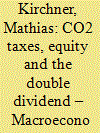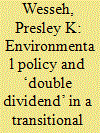|
|
|
Sort Order |
|
|
|
Items / Page
|
|
|
|
|
|
|
| Srl | Item |
| 1 |
ID:
116989


|
|
|
|
|
| Publication |
2012.
|
| Summary/Abstract |
Russia is one of the world's major sources of carbon based energy as well as one its most intensive users. Introducing carbon taxes can lead to a reduction in emissions and encourage investment in energy efficiency. We investigate the economic effects of carbon taxes on the Russian economy under perfect competition and a Cournot oligopoly in output markets. The main findings are: (i) substituting carbon taxes for labour taxes can yield a strong double dividend in Russia; however, welfare gains strongly depend on the labour supply elasticity and elasticities of substitution between capital, labour, and energy. (ii) Under the assumption of a Cournot oligopoly with homogenous products and symmetric firms in the markets for natural gas, petroleum and chemical products, metals, and minerals, welfare costs of the environmental tax reform can be higher than under perfect competition. This is because introducing carbon taxes leads to a reduction in already sub-optimal output, thereby exacerbating pre-existing distortions arising from imperfect competition. (iii) Furthermore, increases in energy costs can result in higher mark-ups in some markets because of less competition resulting from firms' exit.
|
|
|
|
|
|
|
|
|
|
|
|
|
|
|
|
| 2 |
ID:
163553


|
|
|
|
|
| Summary/Abstract |
This paper investigates the impacts of CO2 tax schemes on CO2 emissions, equity and macroeconomic indicators in Austria with the macroeconomic model DYNK[AUT]. Our scenarios focus on non-ETS CO2 emissions and comprise different tax rates and revenue recycling options (lower labor taxes, lower VAT and lump sum payments). The short-term comparative scenario analysis indicates that CO2 taxes without recycling lead to significant CO2 emission reductions at moderate economic costs. Equity impacts on households depend on the indicator used but can be regressive without recycling. Most recycling schemes can achieve a double dividend, i.e. emission reductions and increases in GDP. Lump sum payments are less efficient than reducing the VAT or labor taxes. Equity impacts are progressive with lump sum payments, rather proportional with lower VAT and regressive with lower labor taxes. A combination of recycling schemes and/or a restriction of lump sum payments to lower income households can minimize the trade-off between equity and efficiency. Our simulations suggest that well-designed CO2 tax schemes could be a crucial and socially acceptable element within a comprehensive policy package to achieve GHG emission targets for non-ETS sectors in Austria.
|
|
|
|
|
|
|
|
|
|
|
|
|
|
|
|
| 3 |
ID:
096124


|
|
|
|
|
| Publication |
2010.
|
| Summary/Abstract |
There is a considerable body of literature that has studied whether or not an adequately designed tax swap, whereby an ecotax is levied and some other tax is reduced while keeping government income constant, may achieve a so-called double dividend, that is, an increase in environmental quality and an increase in overall efficiency. Arguments in favor and against are abundant. Our position is that the issue should be empirically studied starting from an actual, non-optimal tax system structure and by way of checking the responsiveness of equilibria to revenue neutral tax regimes under alternate scenarios regarding technological substitution. With the use of a CGE model, we find that the most critical elasticity for achieving a double dividend is the substitution elasticity between labor and capital whereas the elasticity that would generate the highest reduction in carbon dioxide emissions is the substitution elasticity among energy goods.
|
|
|
|
|
|
|
|
|
|
|
|
|
|
|
|
| 4 |
ID:
094873


|
|
|
|
|
| Publication |
2010.
|
| Summary/Abstract |
Faced with pressure from greenhouse gas reductions and energy price hikes, the Taiwan government is in the process of developing an energy tax regime to reflect environmental external costs and effectively curb energy consumption, as well as mitigate CO2 emissions through an adequate pricing system. This study utilizes a CGE model to simulate and analyze the economic impacts of the draft Energy Tax Bill and its complementary fiscal measures. Under the assumption of tax revenue neutrality, the use of energy tax revenue generated for the purpose of reducing income tax is the best choice with double dividend effects since it will effectively stimulate domestic consumption and investment, and, consequently, mitigate the negative impacts of the distortionary tax regime. The double dividend effect is less significant, however, when the supplementary measures being used are for government expenditure. Nevertheless, all supplementary measures have effectively reduced energy consumption, which means they have delivered at least the first dividend-in the sense of CO2 emissions control. It has been verified in this study that having adequate public-finance policy measures is the key to realizing the double dividend effect.
|
|
|
|
|
|
|
|
|
|
|
|
|
|
|
|
| 5 |
ID:
169734


|
|
|
|
|
| Summary/Abstract |
Although the environmental benefit from implementing a climate tax is usually realized, the economic dividend still remains a controversial issue warranting further research. This is because the impact of an environmental policy on an economy-wide system will depend on factors that differ from one region to the next. In this paper, we develop a static CGE model for Liberia that is capable of analyzing both a uniform and a partial carbon tax policy. Under the uniform policy instituted to ensure mitigation in the range of 20–50%, an economic dividend is found for energy, employment, and welfare. In particular, energy consumption increases by between 5 and 15.5%, respectively. Interestingly, under a second best policy which exempts economically strategic sectors from the tax, no economic dividend is found for all three variables. This time, energy use declines by between 2 and 9%. These suggest that a uniform environmental tax policy is a more viable option for Liberia, in particular, as it does not only generate economic dividend for employment and welfare, it also incentivizes Liberia's adoption and use of renewable energy technologies. In general, based on the results obtained, further conditions for the feasibility of a double dividend are proposed.
|
|
|
|
|
|
|
|
|
|
|
|
|
|
|
|
| 6 |
ID:
107505


|
|
|
|
|
| Publication |
2011.
|
| Summary/Abstract |
In an stylized endogenous growth economy with a negative externality created by CO2 emissions and in which abatement activities are made by private firms, we find a wide range of dynamically feasible green tax reforms yielding the double dividend without any need to assume a complex production structure or tax system, or a variety of externalities in production. As a remarkable finding, we obtain certain scenarios in which increasing the emissions tax up to the Pigouvian level and removing completely the income tax is dynamically feasible and, also, it is the second-best reform. Hence, as a difference to previous literature, in these scenarios the first-best tax mix is implementable, allowing for the elimination of both environmental and non-environmental inefficiencies. Our result arises because of the consideration of public debt issuing and the management of the government budget balance with an intertemporal perspective. The result is obtained for an intermediate range of environmental bearing in preferences, the valid range being contingent on the pre-existing income tax rate. The type of tax reform that we propose could also be implemented for different energy taxes.
|
|
|
|
|
|
|
|
|
|
|
|
|
|
|
|
| 7 |
ID:
099258


|
|
|
|
|
| Publication |
2010.
|
| Summary/Abstract |
There is increasing global interest in market-based climate change policies following the last elections in the United States. In this context an Exxon Mobil chief executive came out in favour of a carbon tax. This paper is concerned with the welfare analysis of Environmental Tax Reforms (ETR), and takes up the claims for the need of an unambiguous and operative definition of the double dividend both for empirical purposes and political advisement. In this paper, we contest the usual definition of the second dividend and its assimilation to an "efficiency dividend". We propose alternative definitions by suggesting a different splitting of the total welfare variation between the first and the second dividend in order to isolate the efficiency effects of the ETR. The new definitions become clearly understandable and easy for economic and policy interpretation. Concepts like "weak" and "strong" double dividend turn out to be unnecessary. Finally, we analyze ETR for the US economy to illustrate the advantages of the proposed definitions for policy implementation.
|
|
|
|
|
|
|
|
|
|
|
|
|
|
|
|
| 8 |
ID:
150000


|
|
|
|
|
| Summary/Abstract |
This paper simulates the medium- and long-term impact of proposed and expected energy policy on the environment and on the Mexican economy. The analysis has been conducted with a Multi-sector Macroeconomic Model for the Evaluation of Environmental and Energy policy (Three-ME). This model is well suited for policy assessment purposes in the context of developing economies as it indicates the transitional effects of policy intervention. Three-ME estimates the carbon tax required to meet emissions reduction targets within the Mexican “Climate Change Law”, and assesses alternative policy scenarios, each reflecting a different strategy for the recycling of tax revenues. With no compensation, the taxation policy would reduce CO2 emissions by more than 75% by 2050 with respect to Business as Usual (BAU), but at high economic costs. Under full redistribution of carbon tax revenues, a double dividend arises: the policy appears beneficial both in terms of GDP and CO2 emissions reduction.
|
|
|
|
|
|
|
|
|
|
|
|
|
|
|
|
|
|
|
|
|